I get asked this a lot. “Where’s your favorite place?” “What’s the best place you’ve been?” I thought I’d tell you about the places I’ve been that left a lasting impression. That’s actually a bit misleading. I LOVE everywhere I go. Because I love to travel and I find something interesting or memorable in every destination. But the trip that stands out the most to me was when I was my trip to Jordan.
Where is Jordan?
Jordan is a country located at the crossroads of the Middle East. It is surrounded by Saudi Arabia to the south, Iraq to the northeast, Syria to the north, Israel and Palestine to the west, and the Red Sea to the southwest. Its diverse landscape encompasses the dramatic Jordan Rift Valley, the otherworldly Dead Sea (the lowest point on Earth), the enchanting desert of Wadi Rum, and the lush highlands in the north. The cultural tapestry of Jordan weaves together ancient traditions and modern influences. A rich Bedouin heritage adds to the depth to its identity. This blending of old and new has contributed to its standing as a captivating destination in the Middle East.
As one of the cradles of civilization, Jordan has been inhabited since ancient times, hosting a myriad of cultures throughout history. These include the Ammonites, Moabites, and Edomites. The Nabateans, an ancient Arab people, left an indelible mark with their capital city of Petra, now a UNESCO World Heritage site and one of the New Seven Wonders of the World. With a subsequent history as part of the Roman Empire, the impressive ruins of Jerash showcase remarkably preserved Roman architecture. Following this era, it became part of the Byzantine Empire, further shaping its historical narrative.
Jordan boasts several noteworthy cities. Amman, the vibrant capital, seamlessly blends modernity with ancient ruins such as the Citadel and the Roman Theatre. Aqaba, a bustling port city along the Red Sea, is renowned for its rich marine ecosystem and popular diving sites. Petra, an archaeological marvel, is famed for its intricate rock-cut architecture and sophisticated water conduit system.
My Trip To Jordan
The country’s tourism bureau wanted to show tourists that it is safe to travel to Jordan. The country places a very high priority on ensuring that its visitors are safe. I can tell you on my 10 day trip to Jordan, whether I was in the desert or the crowded city of Amman, I never felt unsafe. We stayed in Jordan luxury hotels that were simply stunning and did everything Jordan sightseeing has to offer.
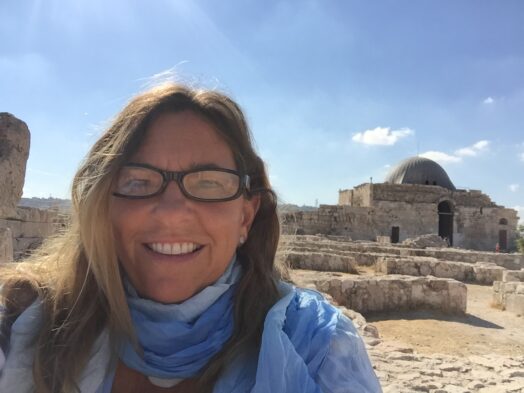
Back to that question I’m often asked about my favorite trip. I generally answer with, “It depends.” It depends on the experience I had rather than the place. So if I’m talking about learning a new culture and pure once in a lifetime experiences, Jordan is my favorite.
When the trip was first offered to me, I honestly had little interest. I’m not much of a history buff, and at the time, I was not that adventurous of a traveler. This trip to Jordan, however, would change all of that! I was apprehensive about going (like you, I asked Is it safe to travel to Jordan?), but a friend who had been on the same trip the year prior said, “You have to go. It’s the trip of a lifetime!” So I committed to going but had my usual frequent “I’m just going to cancel” internal discussions up until the day I left.
I did minimal research on the country (note to self: get better at this) mainly to ensure I packed appropriately. The cultural norms and the weather dictate attire. You have the heat and dust of the desert, but women should cover most of their arms and legs (capris and three-quarter length tops are acceptable). I even bought a one-piece bathing suit for the Dead Sea portion of the trip. Then I learned that bikinis are perfectly acceptable in these tourist-heavy areas.
There were 10 other people traveling, only two who I knew at JFK Airport on the afternoon of our flight. I didn’t know if we’d all be sitting together on the plane, since I jockey my long-haul seat assignments much like a Vegas oddsmaker. Since I wanted a row to myself to sleep (I don’t sleep well sitting up on planes), I watched the seating chart several times a day leading up to the flight. Anyway, we would all meet, nine women and one man, at a restaurant for dinner before boarding our flights to Jordan on Royal Jordanian.
Believe it or not, as much as I travel, I’m still nervous and anxious through that whole boarding process until we’re in the air. (Thank you, Xanax.) As I sat on the plane, in my empty row mind you!, getting my area and all of my nighttime comfort accoutrements in order, I pulled out my wallet to get my credit card for my nightcap(s), and it was not there! I suddenly realized that my anxiety in the evening got the best of me, and I left my credit card in the portfolio at the restaurant.
At this point, the cabin doors were closed. I texted my husband, but by the time he responded, we were in the air. I panicked. Despite being an accomplished traveler, no, I did not carry cash, and I did not have a backup debit card. I did have another credit card, but it was not set up for cash withdrawals. And despite my bank advertising that they’re a 24/7 business, when I landed in Jordan, their phones went unanswered. I eventually worked it out, so I’ll get on with the details of the trip.
We landed in the capital city of Amman. We’d spend the first night there before we began a 10-day, 10-hotel (!) journey around the country. I barely remember that first night after our long journey, but the city was teeming with activity as we walked to dinner. Again, in my awake-for-24-hours-hungover-by-Xanax-and-wine coma, I vaguely remember dinner. It was WAY too much food as generally happens on these trips, but my palate absolutely loved the new flavors I was experiencing. But honestly, all I really wanted was a good night’s sleep.
I better get to the highlights of why this trip to Jordan was the best ever. Keep in mind that we were in 10 different areas of the country with multiple excursions and experiences. Every single experience left me feeling giddy with that “I can die happy now” feeling but I’ll share the highlights with you here.
Visiting the Wadi Rum Desert
Again, I’m a bit of an unapologetic diva when it comes to traveling. I like comfort — things like soft bed sheets, room service, and a luxe bathroom. So, the desert doesn’t fit into my travel mantra, even on a trip to Jordan. (Not to mention that whole “Is it safe to travel to Jordan and sleep in the desert” bit) But, hands down, this was (so far) the best experience I’ve ever had in a things-you-only-get-to-do-once-in-a-lifetime sort of way.
Wadi Rum is a vast desert in Jordan with virtually every type of geographic wonder you could imagine. There are colossal sandstone mountains, desert valleys, canyons, dunes, and stone arches. It served as the film location for several movies, including ‘Lawrence of Arabia’ and ‘The Martian.’ It’s one of the best sightseeing tours in Jordan for those up for a little adventure.
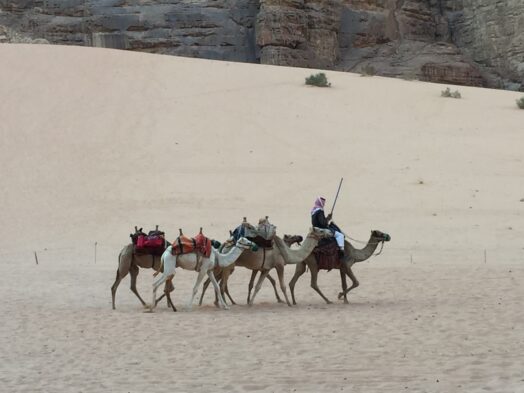
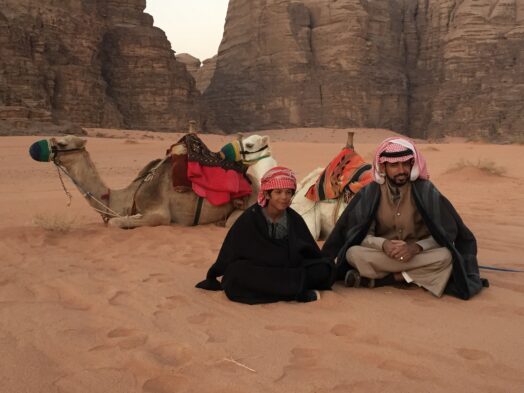
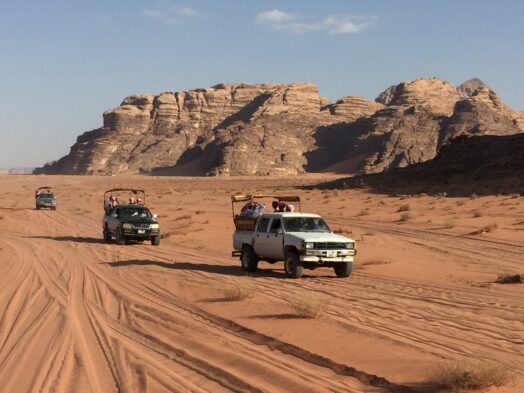
What to do in the Wadi Rum Desert
Our Wadi Rum experience began as we climbed into the back of pick-up trucks and took off across the sandy desert, racing each other, stopping for the occasional photo opp, and just experiencing the amazing scenery. Clearly, our hosts wanted to impress this group of travel writers. We arrived at a spectacular spot in the desert just as the sun was falling. Our guides had created a semi-circle of luminaries as we sat and watched the sunset across the stillness of the desert. It was one of those sights I will never ever forget.
There would be no luxury hotel for my weary head. To fully immerse in our desert experience, we would be staying at a Bedouin campsite, Rahayeb Desert Camp. It was camping, albeit in individual yurts with attached yet primitive bathrooms. But like a true camel in the desert, I learned to “hold it” as I entered my bathroom before the 10 p.m. power curfew only to find a spider larger than my hand perched on the mirror above my sink. I was in for another sleepless night. I certainly did NOT expect this on my trip to Jordan.
Camping in the Wadi Rum Desert
Fortunately, my night would be short as we had a pre-dawn wake-up call to ride camels across the desert to watch the sunrise. Three Bedouins, one who looked to be about ten years old, helped us each mount a camel (three words I thought would never come out of my mouth as a phrase) in the pitch dark. If you’ve never mounted a camel, it’s a great feat of strength, both mentally and physically, as the camel lurches forward onto his front legs, making you feel as though you’re going to fly over the so-called handlebars. Still, the trick is to relax and just let the wave of the animal’s movement take over. It was pretty spectacular.
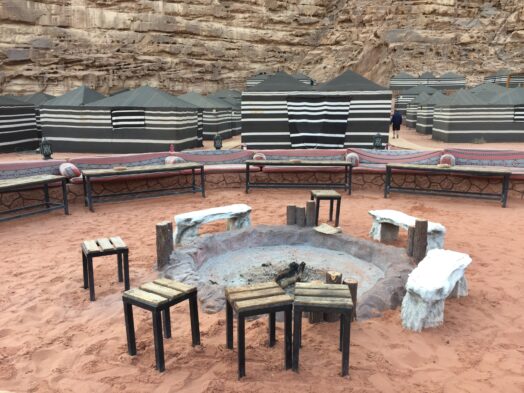
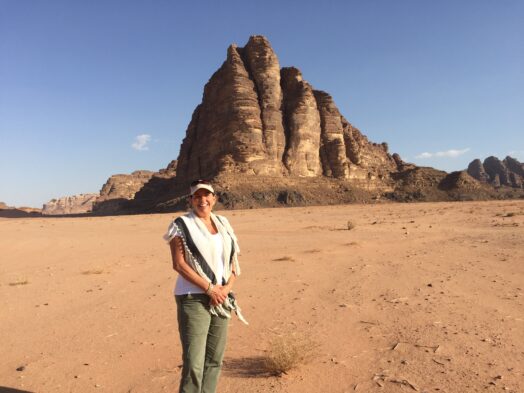
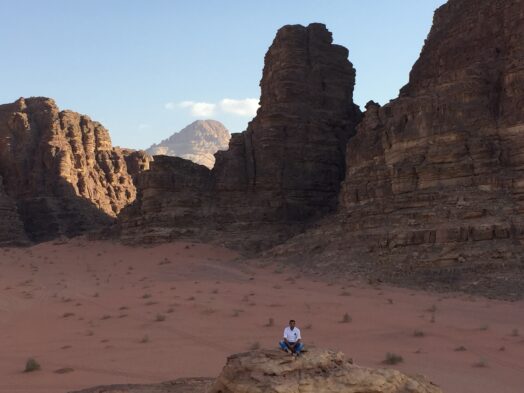
A group of us traipsing across the desert as the sun rose above the mountains. Me. In the Middle East. On a camel. Watching the sunrise. Best moment of my life! (Wow! I got misty-eyed writing that sentence.) Truly a highlight and one of my favorite spots from my trip to Jordan.
And then my cell phone pinged. Seriously! A text message. In the middle of the freaking desert!
Visiting Petra On Your Trip To Jordan
No one should ever take a trip to Jordan without a visit to Petra. Again, I’m not much of a history buff, but the city of Petra gave me pause! We stayed at the nearby Petra Marriott Hotel, which offered quick and easy access to this iconic site. The travel diva in me came out as right after check-in, I ventured down to the hotel’s spa for my first hammam, or Turkish bath, experience. When in Rome… er Jordan. Right?
Petra is one of the top vacation spots when you travel to Jordan for history lovers. Two pieces of advice for going inside Petra. 1) Get an early start. Seriously. I could have spent two whole days there just exploring. 2) Splurge and hire a guide. If there’s anything I’ve learned as a travel writer, it’s how much more enriching a destination or site can be if you have a professional guide. And as with many adventurous tours, wear comfortable shoes, take plenty of water, and wear a hat inside Petra.
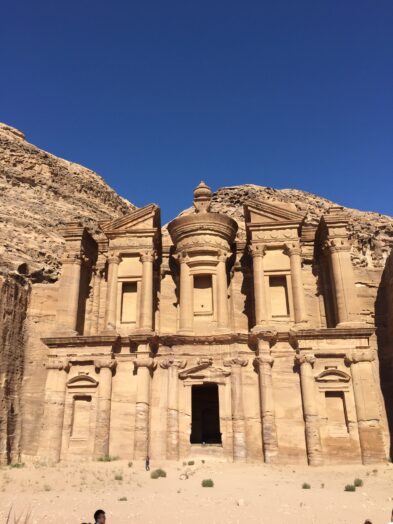
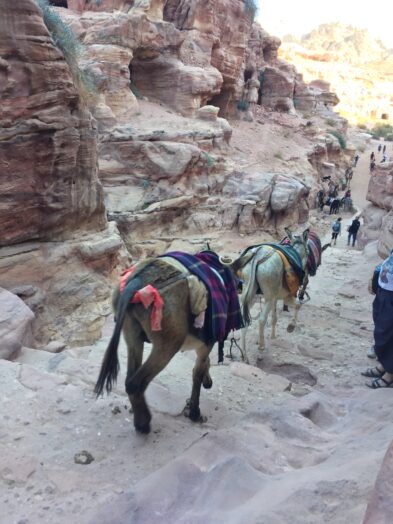
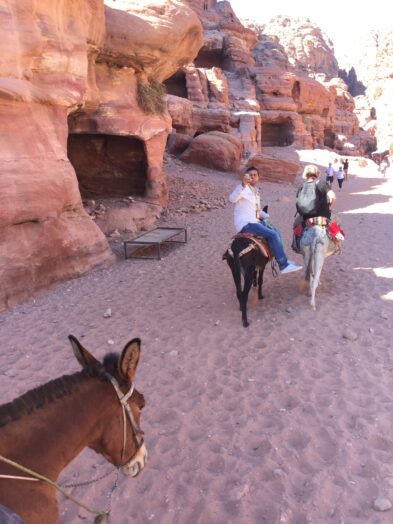
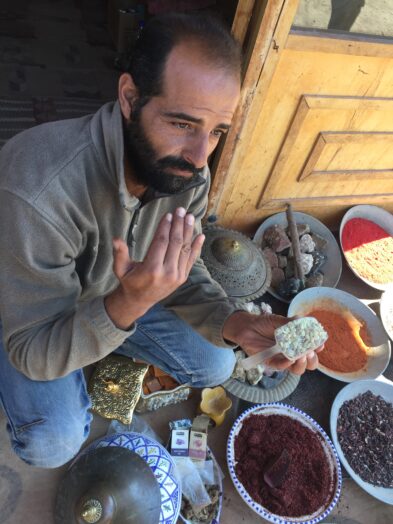
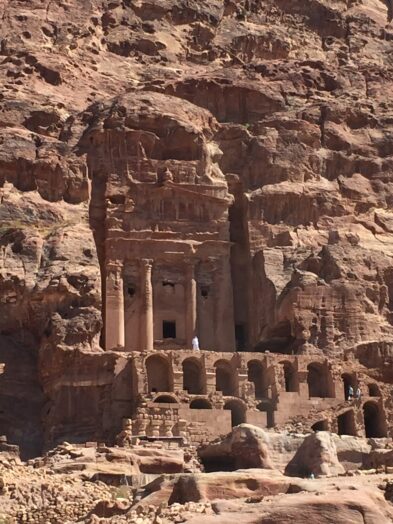
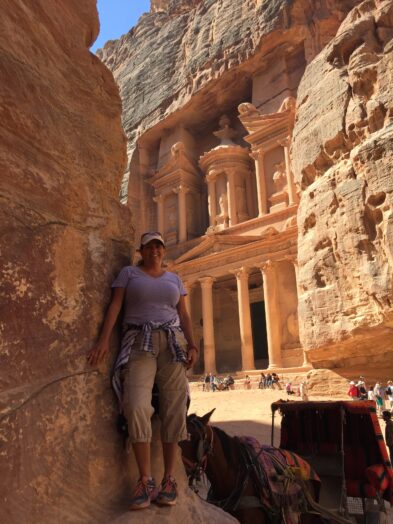
What is Petra?
Because I didn’t pay much attention to history in school, I decided to let Google answer this. “Petra is a famous archaeological site in Jordan’s southwestern desert. Dating to around 300 B.C., it was the capital of the Nabatean Kingdom. Accessed via a narrow canyon called Al Siq, it contains tombs and temples carved into pink sandstone cliffs, earning its nickname, the “Rose City.” Perhaps its most famous structure is 45m-high Al Khazneh, a temple with an ornate, Greek-style facade, and known as The Treasury.” So there. The Treasury is most famous as the site in the “Indiana Jones and the Last Crusade” movie.
Petra inside was designated a UNESCO World Heritage Site in 1985. In 2007, Petra earned the designation as one of the New Seven Wonders of The World.
Taking a Petra Tour
Our tour of Petra started with a walk down the Siq, a narrow gorge bordered by towering pink sandstone cliffs. It’s about a one-mile walk to The Treasury but can (and should) take longer, especially if you have a guide. The trail has so much history along the way marked by facades, tombs, and residences.
The gorge gets quite narrow, claustrophobic almost, but suddenly, The Treasury comes into view. And it is stunning! It’s a massive 43-meter tall Greek-style temple carved into the sandstone. And while most people consider this Petra’s main feature, it’s really only the beginning. There are so many uncovered civilizations and ruins spread throughout the area.
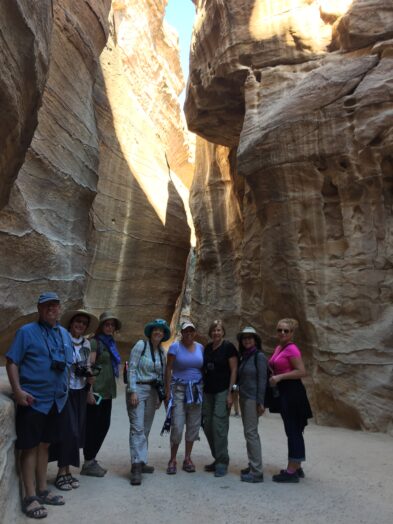
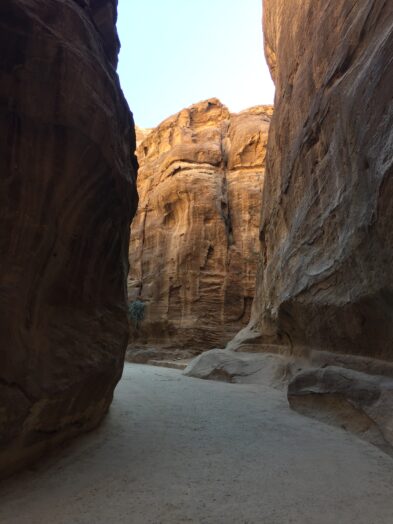
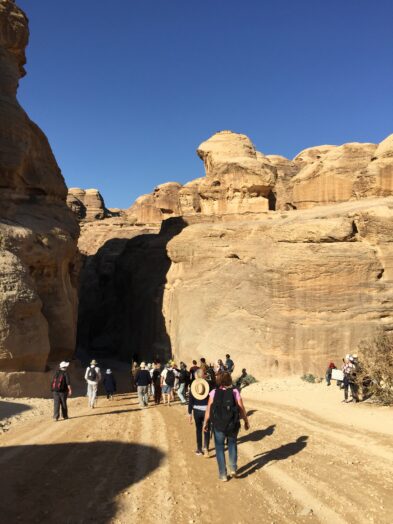
The Monastery sits high on a hill and is just as spectacular as The Treasury, in my opinion. It’s not easy to get to. It’s a hot, dusty climb up 850 steps carved into the rock. So the adventurers in us decide to take the donkeys up. This is not for the faint of heart. We were terrified, but laughing so hard, as the donkeys mechanically prance up the stairs, occasionally fighting each other for position, as you’re hanging on for dear life. A nerve-wracking but hysterical experience!
At night, people walk the Siq to see The Treasury at night, surrounded by luminaries as guides put on a brief show. You’ll need a flashlight as the towering sandstone walls block out even the moonlight but the night I went, it was fairly crowded.
Visiting Jerash in Jordan
Petra is simply amazing and something everyone should see if given the opportunity for a trip to Jordan. But I’ll be honest, the not-so-history-savvy me loved Jerash, another site of ruins in Jordan unearthed in this century. I definitely recommend a few hours at this site as well.
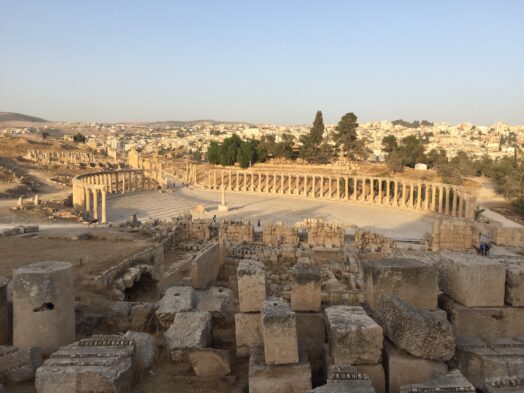
I can’t possibly share this level of detail on everything we saw in Jordan. But it was like each day built upon the one prior.
The Dead Sea and The Red Sea
The two seas are perhaps the most popular thing to see when you travel to Jordan for water lovers. The Red Sea is home to several stunning diving sites, as is The Dead Sea.
Where to stay on The Dead Sea
We stayed at the Dead Sea Marriott Resort & Spa and it was the perfect location. After a night of enjoying the unique water and mud of the Dead Sea, we moved to Kempinski Hotel Aqaba to explore the Red Sea.
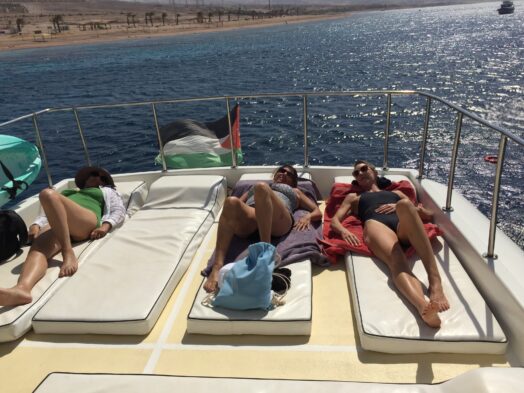
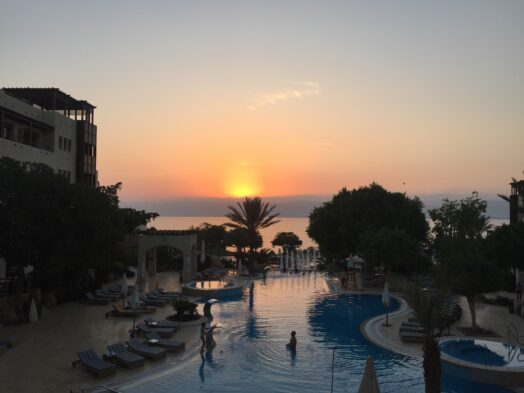
The Jordanian People and Countryside
So again, I want to ask that question that so many ask when I mention they should travel to Jordan. Is it safe to travel to Jordan? YES! The people are so amazing and so many rely on tourism dollars so they go out of their way to make you happy.
One of our stops included a stay at Feynan Ecolodge, which is located at the southwestern edge of the Dana Biosphere Reserve (Jordan’s largest nature reserve), near the villages of Qurayqura and Feynan, respectively. The property is about 215 km (or 133 miles) south of Amman so be sure to visit on your trip to Jordan.
We piled into the back of beaten up pickup trucks and bumped and tumbled across the desert passing a few Bedouin camps as our scarfed driver navigated the dusty path. The 26-room, open-air ecolodge sits alone in the middle of the desert. This destination ranks up there as one of the best places in the world to see the stars. At dusk, we all climbed onto the roof on the lodge and spread out the cushioned mats and laid back as our guide took us on an incredible stargazing journey.
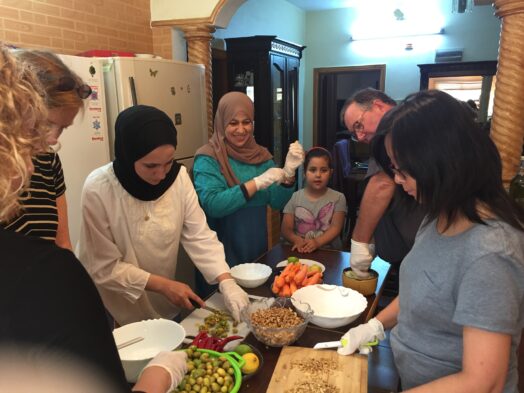
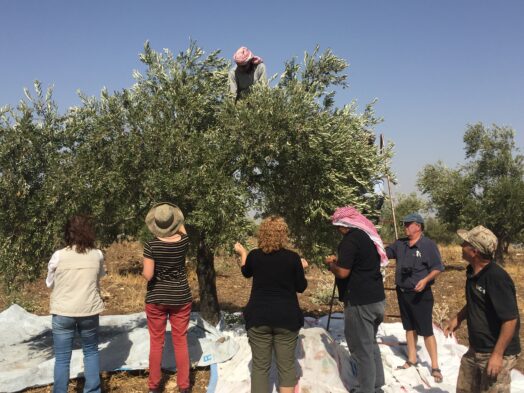
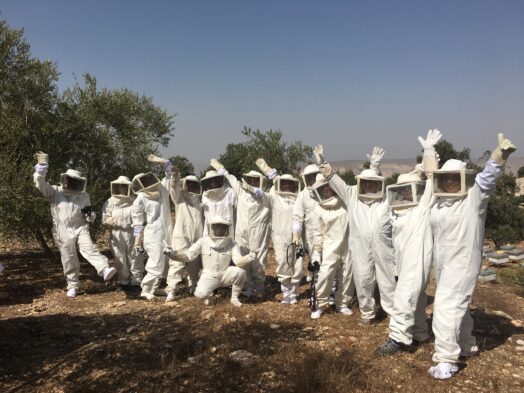
A lot of people ask, “Who are the Bedouins?” The Bedouins are simply the Arab nomads who traveled across the Middle East. They typically travel(ed) in caravans with camels carrying their provisions and set up campsites along the way. They are tribal and live communally with some interesting cultures and traditions.
The Best Time to Visit Jordan
The best time to visit Jordan is during the Spring (March to May) and Autumn (September to November). During these months, the weather is pleasant and ideal for exploring the country’s outdoor attractions, such as Petra, Wadi Rum, and the Dead Sea.
Flying to Jordan
I’m not going to sugar coat it. It’s a LONG flight to Jordan. But using some of my travel hacks, you can find decent fares, and hopefully score a business class lay flat seat.
Is It Safe To Travel To Jordan
Yes, Jordan is a safe country for travelers. It is one of the most stable countries in the Middle East with its hospitality and welcoming atmosphere. However, as with any international travel, it’s important to stay informed about the current situation and follow safety precautions.
Amman is a great place to base yourself if you’re planning to tour Petra and Jerash.
Are thinking of planning a Jordan trip? I’m happy to answer any questions in the comments below.
This blog post may contain affiliate links, meaning that if you click on a link and make a purchase, I may receive a small commission at no extra cost to you. I only recommend products and services I truly believe in and use myself.


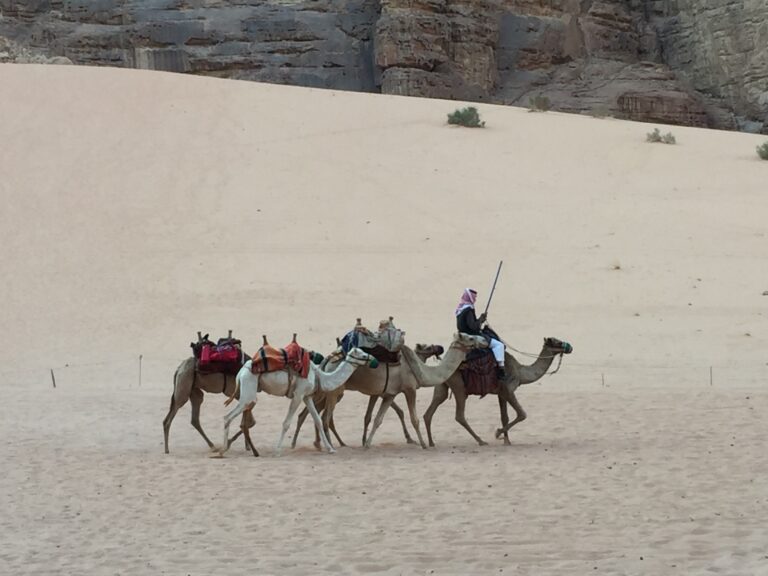
2 comments
HI there:
Enjoyed your article on Jordan – May I asked what travel company (?) was used to book your tour?
I went through Visit Jordan to plan my trip.